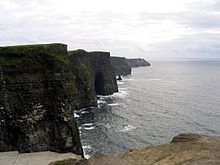Geology of Ireland

The geology of Ireland consists of the study of the rock formations on the island of Ireland. It includes rocks from every age from Proterozoic to Holocene and a large variety of different rock types is represented. The basalt columns of the Giant's Causeway together with geologically significant sections of the adjacent coast have been declared a World Heritage Site. The geological detail follows the major events in Ireland's past based on the geological timescale.
Timeline

The oldest known Irish
About 600 million years ago, at the end of the Precambrian super-eon, what would later become the Irish landmass was in two parts, with one half on the north-western side of the Iapetus Ocean in Laurentia and the other on the south-eastern side in the micro-continent Avalonia, both at a latitude of around 80° South, close to what is now northwest Africa.[5] From the evidence of the Oldhamia fossils found at Bray Head in Leinster, both parts of Ireland were below sea level at this time.[6]
Over the next 150 million years, these two parts moved towards each other, eventually uniting about 440 million years ago.
Between 400 million and 300 million years ago, parts of
Mesozoic

By 250 million years ago, Ireland was at the latitude of present-day Egypt and had a desert climate. It was at this time that most of the coal and sandstone were eroded. The thinner layers of limestone in the south of the country were also partially affected by this erosion. The limestone that was exposed by the disappearance of its sandstone mantle was subject to solution by weakly acidic water resulting in a karstic landscape that can still be seen in the Burren in County Clare.[9] Shortly after this period, organic debris in the seas around Ireland began to form the natural gas and petroleum deposits that now play a role in the economy of Ireland. Then, about 150 million years ago, Ireland was again submerged, this time in a chalky sea that resulted in the formation of chalk over large parts of the surface. Traces of this survive under the basalt lava that is found in parts of the north.[10]
About 66 million years ago, the
Cenozoic
By 25 million years ago, Ireland was close to assuming its present position. From then on, a long period of erosion resulted in considerable
Since about 1.7 million years ago, the Earth has been subjected to a cycle of warm and cold stages and these have, inevitably, affected Ireland. The earliest evidence we have for this effect comes from the period known as the Ballylinian Warm Stage, some half a million years ago. At this time, most of what are now considered to be native Irish trees were already established on the island. The action of the ice during the cold stages was the major factor in bringing the Irish landscape to its current form.[7][16]
Obvious impacts of the
Rocks and soil types

The large central lowland is of
The soils of the north and west tend to be poorly drained
An unusual environment is present in north Clare, in
References
- ^ "Site Synopsis (Inishtrahull)" (PDF). National Parks and Wildlife Service. Archived from the original (PDF) on 2009-03-27. Retrieved 30 January 2008.
- ISBN 0-632-03656-7.
- JSTOR 30002311.
- ^ Hull, Edward; Nolan, Joseph; Cruise, R.J.; M'Henry, Alexander (1890). Memoirs of the Geological Survey (PDF). Dublin: Lord Commissioners of Her Majesty's Treasury. pp. 15, 21. Retrieved 3 February 2016.
- ^ Hill, Jon; Davis, Katie (November 2007). "Precambrian History of England and Wales". GeologyRocks.com. Archived from the original on 7 December 2007. Retrieved 23 January 2008.
- ^ "Fossil at Bray head". Museum.ie. Retrieved 4 February 2016.
- ^ ISBN 0684020947.
- ISBN 9516909213. Retrieved 31 August 2015.
- ^ "Landscapes for living!". European Landscapes. Geological Survey of Ireland. Retrieved 11 January 2008.
- ^ "The Ulster Chalk". Geological Survey of Ireland. Archived from the original on 5 October 2015. Retrieved 31 August 2015.
- ISSN 0009-2541.
- ^ "Northern Ireland – Living World". BBC. September 2004. Archived from the original on 2012-04-07. Retrieved 2013-11-22.
- ^ Sanders, Ian (2007). Six Common Kinds of Rock from Ireland (PDF). Department of Geology, Trinity College Dublin. p. 36.
- ^ Lloyd Praeger D.Sc., Robert (1934). The Botanist in Ireland. Dublin: Hodges, Figgis & Co. p. 13.
- ISBN 978-94-6239-219-9.
- ^ "GSI geology and cuisine". GSI. Archived from the original on 22 September 2012. Retrieved 4 February 2016.
- ISBN 1-85728-054-7.
- ISBN 0-19-821737-4.
- ISBN 0-7735-1817-7.
- Department of the Environment, Community and Local Government. Retrieved 22 November 2013.
- ^ "Giant's Causeway and Causeway Coast". Unesco World Heritage Sites. Retrieved 23 January 2008.
- ^ Brittle tectonism in relation to the Palaeogene evolution of the Thulean/NE Atlantic domain: a study in Ulster (Subscription required) Retrieved on 10 November 2007
- ^ Deegan, Gordon (27 May 1999). "Blasting threatens future of stalactite". Irish Examiner. Archived from the original on 2011-06-29. Retrieved 23 January 2008.
External links
- Geological Survey Maps Collection; Irish Virtual Research Library and Archive, University College Dublin
